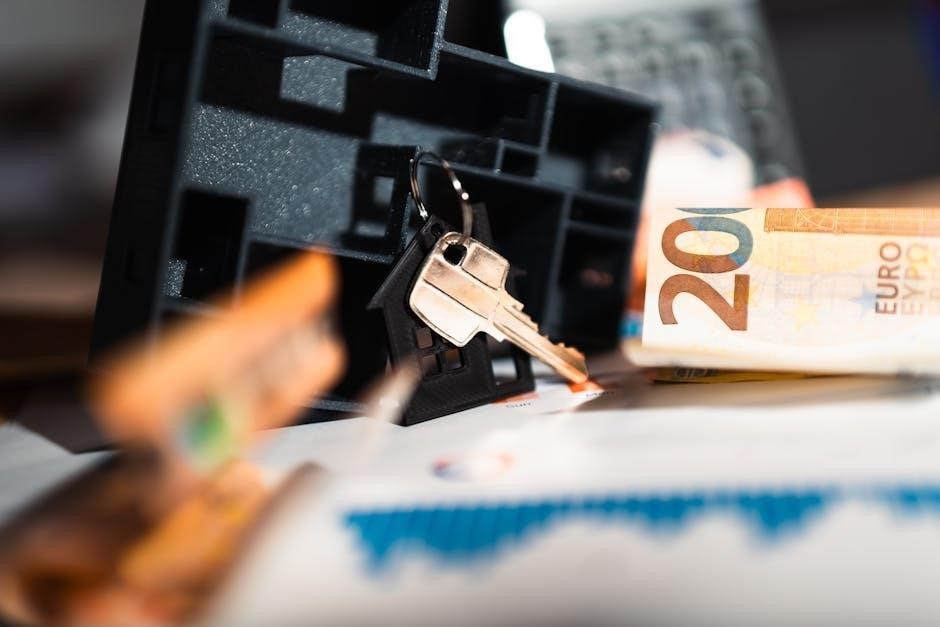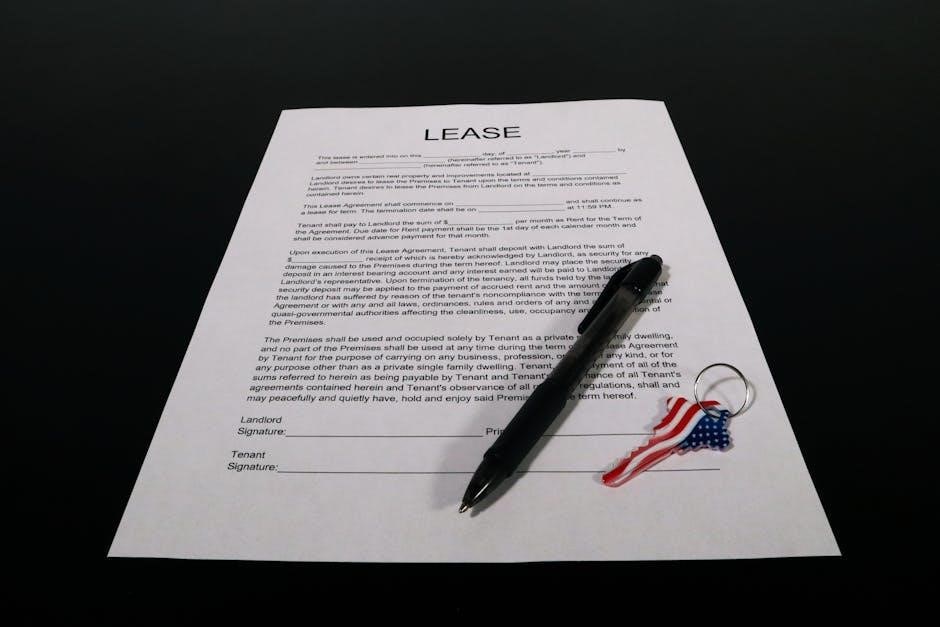lease extension agreement pdf
A Lease Extension Agreement PDF is a legal document extending an existing lease’s term, outlining new dates and terms. It’s a binding contract between landlord and tenant, ensuring continuity while allowing rent or condition adjustments. Using a PDF format provides a professional, easily shareable, and legally recognized template for both parties to formalize the extension seamlessly.
What is a Lease Extension Agreement?
A Lease Extension Agreement is a legally binding document extending the term of an existing lease, outlining new dates and terms while maintaining the original contract’s core conditions.
Definition of a Lease Extension Agreement
A Lease Extension Agreement is a legally binding contract between a landlord and tenant that extends the term of an existing lease. It can be a separate document or an addendum to the original lease, outlining the new lease period and any revised terms, such as rent adjustments or changes in responsibilities. This agreement allows both parties to continue the tenancy under updated conditions without drafting a entirely new lease. It is essential for maintaining legal clarity and ensuring both parties agree to the extended terms, providing a seamless transition beyond the original lease expiration date.
Key Components of a Lease Extension Agreement
A Lease Extension Agreement typically includes the extended lease term, revised rent amounts, and any changes to the original lease conditions. It specifies the new start and end dates of the tenancy, ensuring clarity on the duration of the extension. The agreement may also outline updated responsibilities, such as maintenance or utility payments, if applicable. Both the landlord and tenant must sign the document, making it legally binding. Additionally, it should reference the original lease agreement to maintain continuity. These components ensure that all parties are aware of their obligations and the terms under which the tenancy will continue, preventing potential disputes.
Why is a Lease Extension Agreement Important?
A Lease Extension Agreement ensures continuity, providing financial stability for landlords and security for tenants. It prevents vacancy risks and maintains a harmonious tenant-landlord relationship while clarifying terms.
Benefits for Landlords

A lease extension agreement offers landlords stability and predictability by securing long-term tenants, reducing vacancy risks, and avoiding marketing costs. It ensures consistent rental income and maintains a positive landlord-tenant relationship. Landlords can also negotiate updated terms, such as rent increases, during the extension process. This agreement provides clarity on property use and responsibilities, minimizing potential disputes. By extending the lease, landlords retain reliable tenants, reducing turnover and associated administrative burdens. Additionally, a lease extension agreement allows landlords to plan for the future with certainty, knowing their property remains occupied under agreed-upon conditions. This mutual benefit fosters a collaborative environment, ensuring the property is well-maintained and generating steady income.
Benefits for Tenants

A lease extension agreement provides tenants with stability and security, allowing them to remain in the property without the hassle of relocating. It eliminates the need for a costly and time-consuming move, offering continuity in their living situation. Tenants also benefit from the opportunity to negotiate favorable terms, such as rent adjustments or improved lease conditions. This agreement ensures predictability in housing costs and living arrangements, which is especially valuable for long-term planning. Additionally, tenants avoid the uncertainty of searching for a new rental property, enabling them to maintain their current lifestyle without disruption. The extension also fosters a positive relationship with the landlord, creating a mutually beneficial arrangement that enhances tenant satisfaction and security.

How to Create a Lease Extension Agreement
To create a lease extension agreement, use a template to outline the new terms, including extended dates and any revised conditions. Ensure all details are clear and legally binding, then finalize with e-signatures for convenience and authenticity.
Step-by-Step Guide to Drafting the Agreement

To draft a lease extension agreement, start by identifying the parties involved, including the landlord and tenant names. Specify the original lease details, such as the property address and initial term dates. Next, outline the extension period, including the new start and end dates. Detail any revised terms, like rent adjustments or changes in responsibilities. Include clauses for signatures, witnesses, and the effective date. Use a template to ensure all sections are covered. Review the document for clarity and accuracy, and consider legal advice to ensure compliance with local laws. Finally, execute the agreement by having all parties sign and date it, with copies provided to both landlord and tenant for their records.

Using Templates for Lease Extension Agreements
Using templates for lease extension agreements simplifies the process, ensuring all necessary details are included. Platforms like pdfFiller and Papersign offer customizable templates that can be filled out online. These tools provide pre-designed forms with fields for lease terms, extension dates, and revised conditions. Tenants and landlords can easily modify the template to suit their needs, saving time and reducing errors. Many templates are legally compliant, covering essential clauses like rent adjustments and term extensions. Once completed, the document can be saved as a PDF and signed electronically using e-signature platforms. This method ensures a professional, error-free agreement that meets legal standards, streamlining the extension process for both parties.
Role of Legal Advice in Preparing the Agreement
Legal advice plays a crucial role in preparing a lease extension agreement, ensuring the document is legally binding and compliant with local laws. A legal professional reviews the agreement to verify that all terms, including the extended lease period, rent adjustments, and any revised conditions, are fair and enforceable. They also ensure that the agreement adheres to regional regulations, protecting both the landlord and tenant from potential disputes. Legal experts can identify and address ambiguities or omissions that might lead to conflicts. Their input guarantees that the agreement is clear, comprehensive, and legally sound, providing peace of mind for both parties. Consulting a real estate attorney is highly recommended to avoid future complications.

Negotiation and Signing Process
The negotiation and signing process involves discussing terms, finalizing agreements, and executing the lease extension. Both parties review and sign the document, often using e-signatures for convenience.
Tips for Successful Negotiation
Tips for Successful Negotiation
Successful negotiation for a lease extension agreement requires clear communication and mutual understanding. Both parties should outline their needs and priorities to reach a fair agreement. Focus on win-win outcomes, ensuring terms like rent, duration, and responsibilities are balanced. Be open to compromise, such as adjusting rent for a longer lease term. Professional legal advice can help navigate complex discussions. Stay organized by preparing all necessary documents and reviewing the original lease. Maintaining a respectful and transparent dialogue fosters trust, leading to a smoother negotiation process. By addressing concerns early and being flexible, both landlord and tenant can achieve a satisfactory lease extension agreement.
How to Sign a Lease Extension Agreement
Signing a lease extension agreement involves several key steps to ensure legality and clarity. First, review the document thoroughly to confirm all terms, including the extended dates and any revised conditions. Use PDF tools like pdfFiller to fill out and e-sign the agreement, or print and sign manually. Ensure both landlord and tenant sign and date the document. Witnesses or notarization may be required, depending on local laws. Once signed, distribute copies to both parties for their records. Digital platforms like e-signature services can streamline the process, offering convenience and security. Proper execution ensures the agreement is legally binding and enforceable, protecting both parties’ interests.

Legal Considerations

A lease extension agreement must comply with local laws, include essential clauses, and be legally binding. Ensure all terms are clear and enforceable to protect both parties’ rights and interests.
Essential Clauses in a Lease Extension Agreement
A lease extension agreement must include specific clauses to ensure clarity and legality. The extension term clause outlines the new lease duration, including start and end dates. Revised terms detail any changes to rent, utilities, or maintenance responsibilities. A compliance clause ensures adherence to local laws and regulations. Additionally, a binding clause confirms the agreement’s legal enforceability for both parties. These clauses protect the rights and interests of both landlord and tenant, ensuring a smooth and legally sound extension process. Properly drafted clauses prevent disputes and provide a clear framework for the extended tenancy.
Compliance with Local Laws and Regulations

Ensuring compliance with local laws and regulations is crucial when drafting a lease extension agreement. Each jurisdiction may have specific requirements, such as rent control policies, eviction procedures, or tenant rights. The agreement must adhere to these rules to avoid legal disputes. For instance, some areas may limit rent increases during an extension, while others may require specific disclosures. It’s essential to research and incorporate all applicable local regulations into the agreement. Failure to comply can result in legal challenges or fines. Consulting with a legal professional can help ensure the document meets all necessary standards and remains enforceable. Compliance protects both parties and maintains the integrity of the extended lease agreement.
Digital Tools for Lease Extension Agreements
Digital tools like PDF editors and e-signature platforms simplify lease extension processes. They enable easy editing, signing, and sharing of agreements online, ensuring efficiency and accessibility for all parties involved.
Using PDF Tools for Lease Extension Agreements
PDF tools are essential for efficiently managing lease extension agreements. Platforms like pdfFiller and Papersign offer features to fill, edit, and sign PDF documents online. These tools allow users to upload lease agreements, fill in relevant details, and e-sign them seamlessly. They also support converting agreements into fillable forms, making it easier for landlords and tenants to collaborate digitally. Additionally, PDF tools ensure that documents are stored securely and can be accessed from any device with internet connectivity. This streamlined process reduces paperwork and accelerates the lease extension workflow, making it more convenient for all parties involved. By leveraging PDF tools, users can ensure accuracy, legality, and a smooth experience in extending lease terms.
Role of E-Signature Platforms
E-signature platforms play a crucial role in streamlining the lease extension process. They enable landlords and tenants to sign agreements remotely, eliminating the need for physical meetings. Platforms like pdfFiller and Papersign allow users to upload lease extension agreements, fill in required fields, and add legally binding e-signatures. These tools also provide real-time tracking, ensuring both parties are informed about the signing status. E-signatures are legally recognized, making the process secure and efficient. By integrating e-signature platforms, lease extensions can be completed quickly, reducing delays and enhancing convenience for all parties involved. This digital approach ensures a seamless and professional experience in finalizing lease agreements.
Common Mistakes to Avoid
Common mistakes include unclear lease terms, missing signatures, and overlooked clauses. Ensure all details are precise to avoid disputes. Always legalize the agreement to maintain its validity and enforceability.
Common Errors in Lease Extension Agreements
Common errors in lease extension agreements often include ambiguous terms, missing signatures, and overlooked clauses. Failing to specify the exact extension period or updated rent can lead to disputes. Another mistake is not legalizing the agreement, making it unenforceable. Ensure all terms, such as start and end dates, rent adjustments, and responsibilities, are clearly outlined. Neglecting to include witness signatures or notarization can also invalidate the document. Using outdated templates or incorrect legal jargon is another pitfall. Always double-check the agreement for accuracy and completeness before signing. Consulting legal advice can help prevent these errors and ensure the agreement complies with local laws.
Best Practices for a Smooth Process
To ensure a seamless lease extension process, start by reviewing the original agreement to identify key terms needing updates. Use a reliable PDF template to maintain professionalism and clarity. Clearly outline the extension period, rent adjustments, and any revised responsibilities. Both parties should thoroughly discuss and agree on all terms before signing. Consider using e-signature platforms for convenience and faster execution. Consider legal review to ensure compliance with local laws and avoid potential disputes. Maintain open communication with your landlord or tenant to address concerns promptly. Finally, keep a digital and physical copy of the signed agreement for future reference. These practices help create a fair, binding, and hassle-free lease extension.
Conclusion
A Lease Extension Agreement PDF is a vital tool for extending tenancy terms efficiently. It ensures clarity, legal compliance, and mutual understanding between landlords and tenants. By using a PDF template, parties can streamline the process, making it professional and accessible. Digital tools like e-signatures and PDF editors enhance convenience, allowing seamless execution from any location. Ensuring the agreement complies with local laws and includes all necessary clauses is crucial for avoiding disputes. Clear communication and legal advice are key to a smooth process. Ultimately, a well-drafted lease extension agreement fosters a positive landlord-tenant relationship, providing stability and peace of mind for both parties. It’s an essential document for maintaining harmony and continuity in rental agreements.
